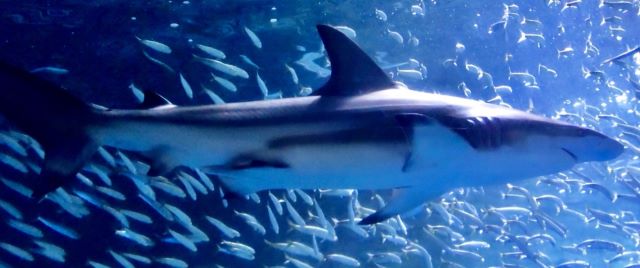
The appearance of Sandbar shark (Mejirozame)
Common name: Sandbar shark, Queriman shark, Thickskin shark, Brown shark, Eatuary shark, Ground shark
Japanese name: Mejirozame (目白鮫)
Taiwan common name: 鉛灰真鯊、大沙、高鰭白眼鮫、黑鯊
French common name: Petit chien bleu, Requin gris
German common name: Atlantischer Braunhai, Braunhai, Großflossenhai, Sandbankhai
Italian common name: Squalo grigio
Spanish common name: Arenero, Cazón, Jaquetón
Portuguese common name: Barriga-de-água, Barriga-dágua, Boca doce, Cação, Cação barriga d’água, Cação galhudo, Cação-baleeiro, Cação-balheiro, Cação-galhudo, Cação-pardo, Galhudo, Marracho de Milberto
Scientific name: Carcharhinus plumbeus (Nardo, 1827)
Nigiri sushi detail: Sandbar shark (Mejirozame) fin Nigiri sushi
Remarks:
Sandbar shark (Mejirozame) is distributed in tropical and subtropical areas in southern Japan and throughout the world. It is found mainly in estuaries and coral reefs. Its length is 1.5~2.5 m. The body color is grayish blue on the back side and grayish white on the belly side.
Although not very popular, shark fins are used for gunkanmaki in shark landing areas such as Kesennuma in Miyagi Prefecture. The shark fins are boiled, torn into thin strips, seasoned, and placed on top. The slightly crunchy texture enhances the flavor.
Shark meat is high in protein and low in fat, and its bones are soft and cartilaginous, making it an easy-to-eat food. It is being newly reevaluated in regions where it has not been customarily consumed. Sharks use urea to regulate osmotic pressure in their body fluids, and urea accumulates in their bodies. However, it decomposes slowly and is prized as a seafood in some mountainous areas.
Most sharks are used to make fish paste products, including kamaboko made from Japanese saw shark, which is considered a high-quality product. Chikuwa, widely available throughout Japan, is made in Hokkaido and Noto regions and is made from Pacific spiny dogfish caught in the northern seas. Salmon shark, starspotted smooth-hound, and dog shark are sold as fillets but are generally considered dried fish.
Share this article